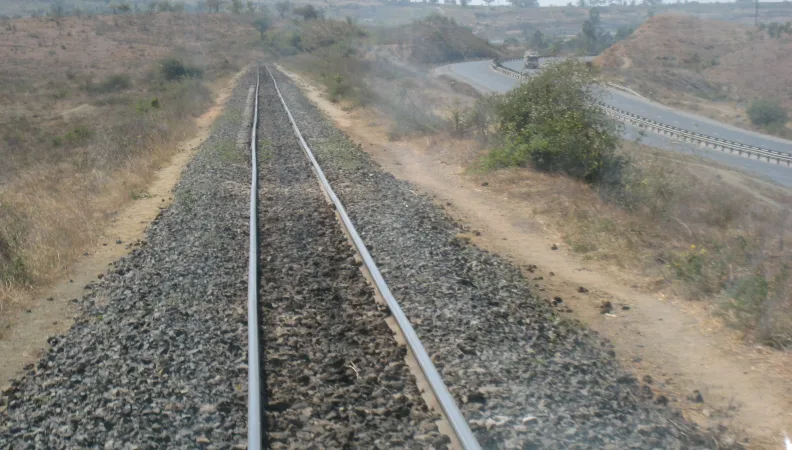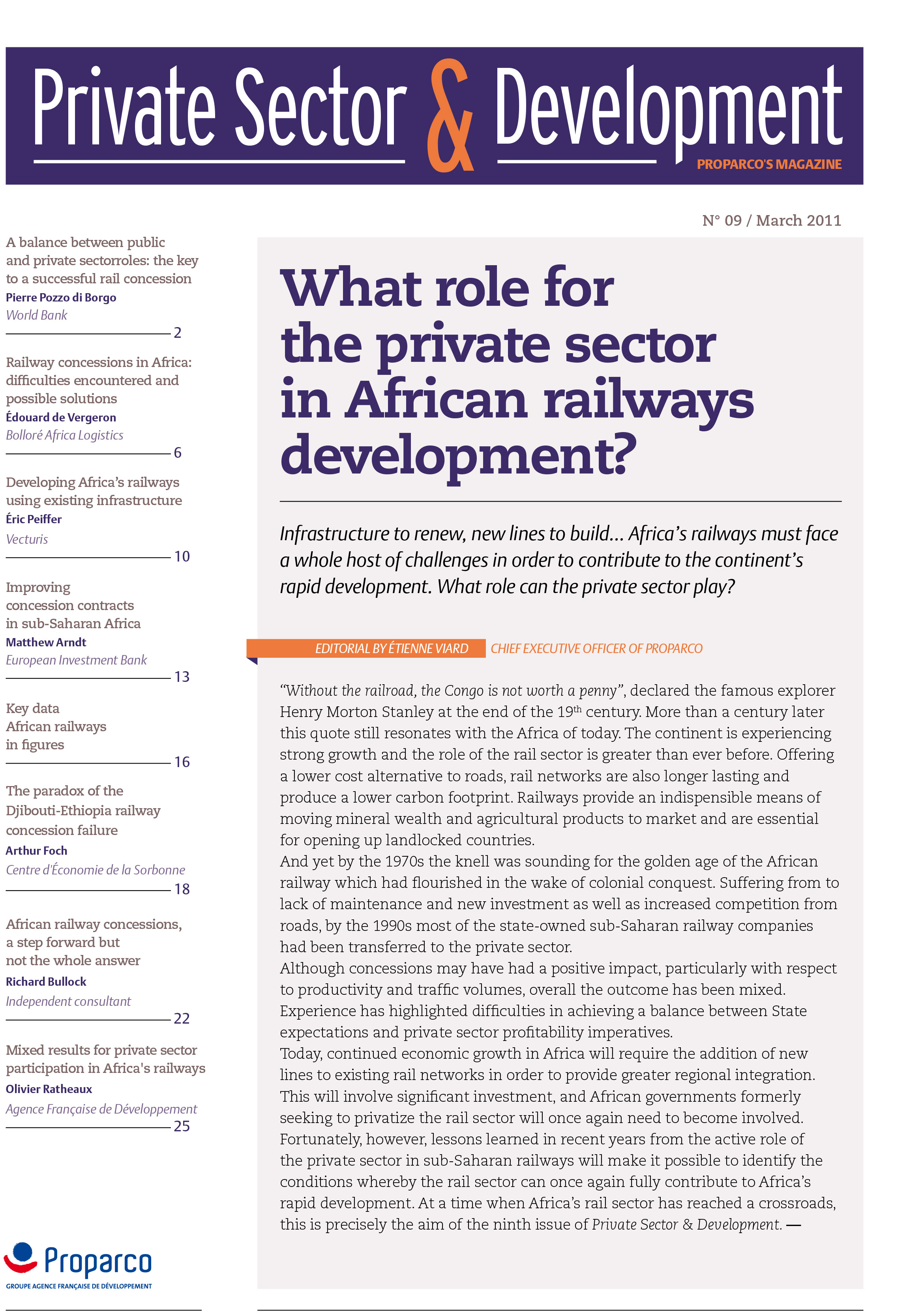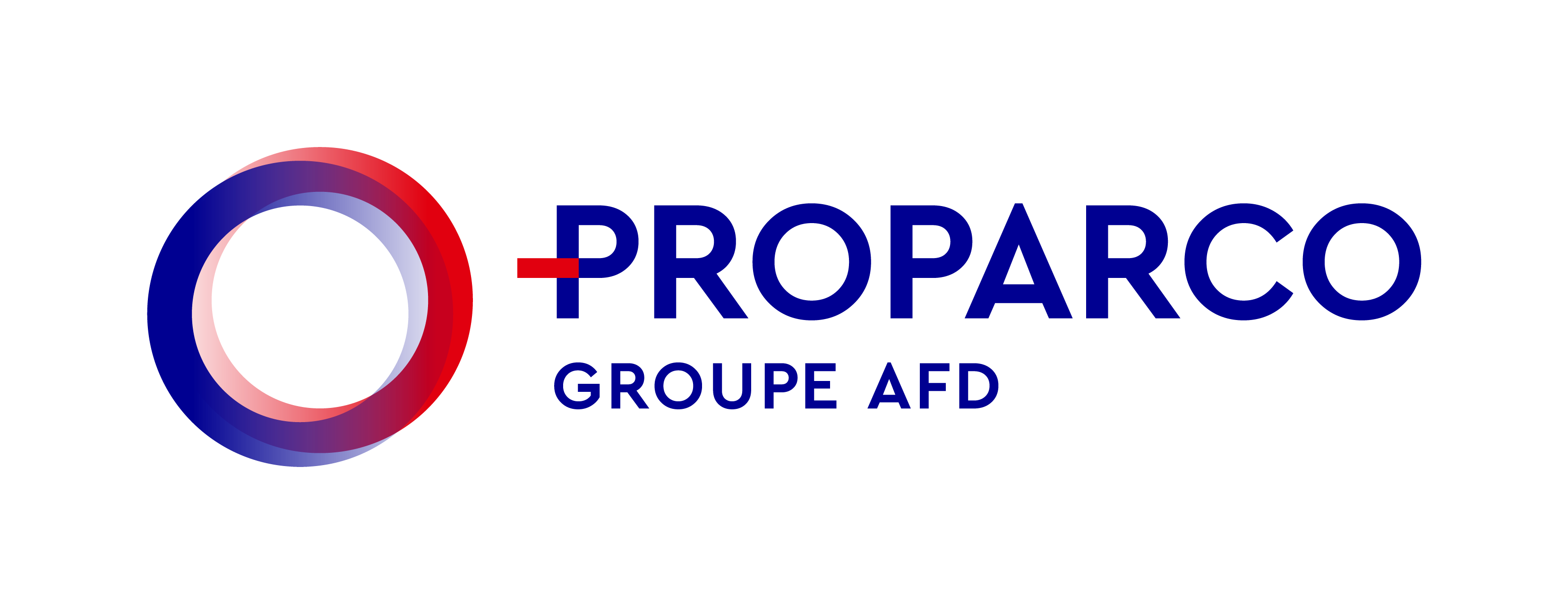Share the page
The paradox of the Djibouti-Ethiopia railway concession failure
Published on
Arthur Foch PhD student in development economics Université Paris 1 – CNRS


Private Sector & Development #9 - What role for the private sector in African railways development?
“Without the railroad, the Congo is not worth a penny”, declared the famous explorer Henry Morton Stanley at the end of the 19th century. More than a century later this quote still resonates with the Africa of today. The continent is experiencing strong growth and the role of the rail sector is greater than ever before. Offering a lower cost alternative to roads, rail networks are also longer lasting and produce a lower carbon footprint. Railways provide an indispensible means of moving mineral wealth and agricultural products to market and are essential for opening up landlocked countries.
The Djibouti to Ethiopia railway line concession ended in failure despite the fact that the rehabilitation project was considered viable and that it was also fully coherent from a political and economical perspective. Whilst part of the failure can be attributed to lack of initial investments carried out by the respective governments, the companies responding to the tender also bear part of the blame because they did not submit realistic offers.
Created in 1981, la Compagnie du chemin de fer djibouto-éthiopien (CDE) is a public company jointly owned by the Djiboutian and Ethiopian governments. At the time it was established, initial expectations were high, with the company expected to play an important role in the economic and social development of both countries.
However, due to poor quality railway tracks and insufficient infrastructure maintenance, the company was by 2000 at an impasse. Trains were slow, de-railings were frequent, and freight clients were generally dissatisfied with the high tariffs which in 2004 averaged USD 55 per tonne compared to less than USD 30 per tonne for road according to Infrastructure Consortium for Africa (ICA, 2007).
As a result of unsatisfactory reliability and relatively high cost, many freight clients began looking for alternative means of transportation. The highway linking Djibouti to Ethiopia offered such an alternative. Whist heavily travelled and previously in very poor condition, it underwent significant repair work in 1998. In 2003, a truck could complete the journey in just three days compared to 12 days by rail (Cabanius, 2003). As rail freight volumes dropped, so did turnover (Table 1). By 2002 the financial situation was so critical that the CDE decided to contact its long-standing partners – the Agence française de développement (AFD) and the European Commission. They agreed to extend aid but only on condition that an operating concession would be granted – an option that both the AFD and the Commission had been recommending since 1990. French regulations governing state aid had changed at this date and the granting of sovereign concessional loans in underdeveloped countries was no longer authorised. Consequently, the AFD could only support the CDE initiative with a non sovereign loan that required the participation of a private profitable operator.
A promising political and economic context
The conflict which broke out between Ethiopia and Eritrea in 1998 was a real boost for the project because it meant that all freight traffic destined for Ethiopia (Table 2) had to be redirected through the Port Autonome International de Djibouti (PAID). Faced with this influx, the two States realised the necessity of rehabilitating the CDE railway – and this by means of a concession which would allow it to play an essential role in freight transport between Djibouti and Ethiopia.
For Djibouti, the rehabilitation of the CDE was particularly important. It would transform the country into a multimodal transport platform, giving it a real competitive edge over other regional ports. This would enable Djibouti to sustain a quasi monopoly over Ethiopian traffic, a real economic driver. In addition, the rehabilitation project would allow the CDE to increase its share of the freight market which at the time was dominated by Ethiopian companies offering more competitive pricing. For Ethiopia, the rehabilitation of the CDE was vital. Apart from the main highway, the railway had been the only other means of access to the landlocked country since 1998. In addition, the CDE railway concession would also provide Ethiopia with a less costly means of transportation when compared with trucking, and more generally enhance the country's overall transport capacity. It was in this context that the Djiboutian and Ethiopian authorities decided to grant an operating concession for the CDE railway. Subsequent to the decision to rehabilitate the CDE, additional evidence became available which tended to indicate this had been an appropriate decision. Broadly speaking, this offered a major cost savings opportunity. According to ICA (2007), the cost of transport by truck was USD 42.80 per tonne, whereas a cost of USD 15.30 to USD 35.60 by rail was considered achievable should a USD 68.6 million investment be carried out. In 2001, the United Nations Conference on Trade and Development (UNCTAD, 2003) reported that in sub-Saharan Africa, transportation costs represented on average 13.8% of the value of imports – and up to 20.7% for landlocked countries like Ethiopia. The decrease in transportation costs would therefore lead to a reduction in the price of goods imported by the two countries, which would in turn increase the competitiveness of exports. Major savings could also be realised through road maintenance and rehabilitation works. At that time 100,000 heavy trucks were using the road every year, and with a 30 tonne truck causing as much road surface damage as 240,000 cars (Cabanius, 2003), high levels of investment would have to be made (exemple: in 2003 EUR 18 million was needed to rehabilitate 100 km of road in Djibouti). Roads needed full rehabilitation every 7 to 10 years, compared to 15 to 20 years for railroads (Pozzo di Borgo, 2011). The rehabilitation of the CDE could also reduce the volume of petrol imports for freight carriers and limit carbon dioxide emission levels. According to Pozzo di Borgo (2011), a railroad's energy consumption and its carbon footprint could be respectively 75% and 85% lower than that for highway.
Government and concession holder responsibilities for the project failure
Despite all of the aforementioned factors, by early 2011 a railway operating concession had still not been granted. For the two governments, the opportunity cost was high due to the savings which could have been realised. Also, the Djibouti Port activity has been restrained by insufficient transport infrastructure, which led to extended shipping delays for Ethiopian goods. According to PAID, the annual financial impact for Ethiopia as a result of these delays is estimated at USD 35 million. The failure of the railway concession project is therefore paradoxical considering that all the necessary conditions had been met, the funding had been secured, and both States were supportive of the project. Above all, the size of the freight market between Djibouti and Ethiopia (4.5 million tonnes in 2006) was enough in itself to justify the rehabilitation project. For example, for operations to be profitable and to justify the investments, only 20% of the market share had to be won compared with 5.5% in 2004, (AFD, 2009). In order to fully understand the reasons behind the failure of this project, looking back at the roles played by the two States as well as those of the bidding companies is necessary. Following a call for tenders, the COMAZAR consortium was selected in 2004 as the preferred bidder, but negotiations with the two governments broke down and by 2007 COMAZAR had lost the deal. The governments subsequently began discussions with the Kuwaiti firm Al Ghanim & Sons. Once more, negotiations broke down. Clearly the two contracting authorities needed to assume their share in the responsibility for the two successive failures. They never fully respected the bidder prerequisites for the signing of the concession agreement. For example, in Djibouti, the rail link to Doraleh, on which the profitability of the railroad depended has still not been completed. In Ethiopia, the rehabilitation of 114 km of rail track financed by the European Commission in 2006 was falling further and further behind schedule. In addition to complicating the negotiation process itself, the bilateral nature of the CDE made respecting the prerequisites difficult. Despite common interests, there was insufficient cooperation in the management of the company. Disagreements began to appear with the first call for tender: the late submission of the COMAZAR bid, backed by Djibouti, provided Ethiopia with a good reason to demand COMAZAR's withdrawal. Again in 2007, Ethiopia showed little sign of flexibility or patience during the negotiations with Al Ghanim when the situation started to get complicated. Perhaps Ethiopia's political commitment to the CDE rehabilitation project was not as strong as it appeared to be. When looking more closely, it can bee seen that two Ethiopian state-owned firms had a monopoly over freight forwarding and maritime transport, and the road freight market was dominated by three highly influential Ethiopian companies. The CDE rehabilitation project was not in the best interest of any of these companies. The bidders also bear some responsibility for the failure of the concession project. Despite a preference for a partial operating concession, the COMAZAR consortium did end up agreeing to pay for rolling stock maintenance and operating investments and to invest in infrastructure. With a total investment of USD 100 million announced (Africa Intelligence, 2006), it was aiming to generate 777,000 tonnes of freight traffic in the first year, followed by 1 million tonnes in year 2, and revenues of USD 50 million by year 5. These objectives were ambitious and would have placed the CDE among the most active and most profitable of the sub-Saharan railway operators. For the experts, the bid was opportunistic and failed to take into account the time necessary for track and rolling stock rehabilitation works. Above all, COMAZAR suffered from a lack of coordination and never put together enough capital to be credible in the eyes of the lenders or the participating governments. The Al Ghanim bid was even more optimistic, with forecast annual traffic of 5.8 million tonnes in 2012. This meant that in the space of four years, the CDE would have had to capture all freight transported by land. In addition, the USD 200 million investment to be made by the concessionaire was considered to be economically unrealistic by the funding institutions in light of effective annual traffic and limited revenue potential.
The role of financing institutions and the future of the railroad sector
Beyond the political obstacles – which played a predominant role in the breakdown of negotiations – could support provided by the funding institutions have been allocated differently in order to improve the feasibility of the concession project? French aid was subject to too many conditions and prevented the AFD from granting a sovereign loan guaranteed by the State, and this complicated the CDE concession process. In contrast, European aid appears to have been provided too freely. There were no suitably adapted conditions imposed on the grants made by the European Commission. Rather than simply making full payment contingent on the signature of a ‘concession agreement', which actually provided no guarantee whatsoever, the Commission could have instead structured the financing in two tranches, linking the second to the actual signature of the concession contract. Furthermore, monitoring of the project that had been financed by the European grant was unsatisfactory. For example, in 2009 only five kilometres of track had been rehabilitated. Lastly, the simultaneous role of the European Commission in both rail and road sectors was ill advised. The Commission simultaneously granted development aid for road and rail corridors: in 2007, 25% of the amount of the 9th European development fund destined to Djibouti was granted to the road sector (European Union and Republic of Djibouti, 2007). By rendering the regional road corridor operational, the Commission permitted both governments to postpone the rehabilitation of the CDE which had become less of a shortterm imperative. In hindsight, if the work on the road corridor had been delayed for a short while, the rail rehabilitation project would have retained some degree of urgency. Another solution would have been to make the financial aid for the road corridor works conditional on significant progress in the CDE concession process (customs reform, rehabilitation work, etc.). Today the effort to carry out the concession process is falling further and further behind. Financing is a problem for government authorities, which have neither funds to finance them nor sufficient support from the funding institutions. Whilst the AFD and the European Commission had made their support conditional on the finalisation of a concession agreement, the bidders had made the signature of a concession agreement conditional on the completion of works which require external financing. As can be seen, the project seemed to have become permanently entangled in a vicious cycle. The two States gradually abandoned the CDE, which by 2011 had ceased all activities. More recently they have launched negotiations with Chinese and Indian partners for the construction of a new electric railway line. For Western experts, this project could never attain profitability considering the amount of required infrastructure investment and the minimum level of traffic (estimated at between 5 and 10 million tonnes per year). This being said, the success of the modernisation of the Djibouti port, carried out with the help of aid from Dubai, has led the Djibouti and Ethiopian governments to believe that a similar approach could be applied to the rail sector (Foch, 2010).
References

